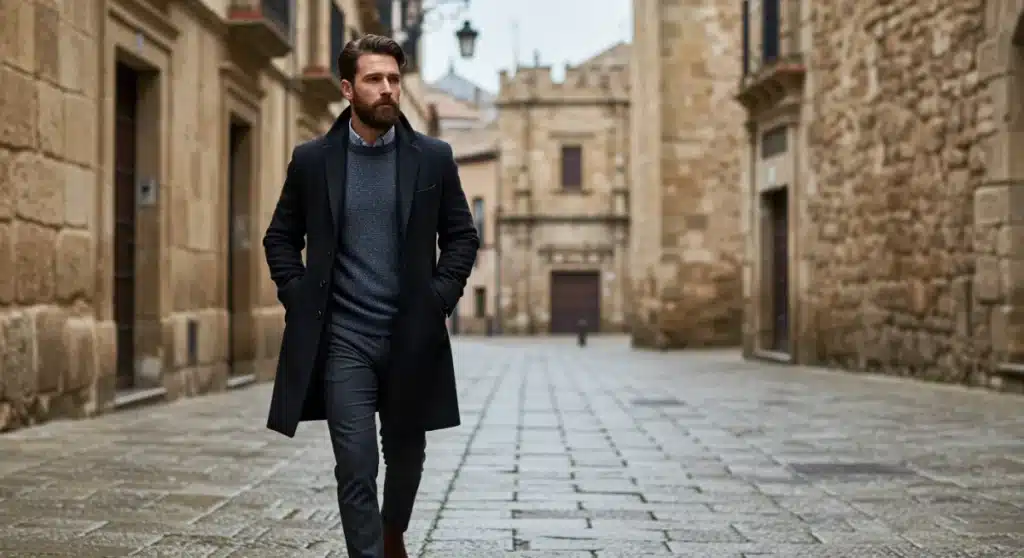Mastering Men’s Winter Layering in Spain: Stylish Warmth

Anúncios
Mastering men’s winter layering in Spain is essential for combating varied temperatures across regions, requiring a blend of strategic fabric choices and versatile pieces to ensure comfort and style through March.
Anúncios
As winter descends upon Spain, bringing with it a surprising range of temperatures across its diverse regions, the art of mastering men’s winter layering in Spain becomes not just a matter of comfort, but a cornerstone of smart style. From the chilly peaks of the Pyrenees to the milder Mediterranean coasts, dressing effectively requires more than just throwing on a thick coat; it demands a thoughtful approach to combining garments that offer both warmth and adaptability.
Understanding Spain’s Diverse Winter Climate
Spain, often perceived as a perpetually sunny destination, experiences a surprisingly varied winter climate. From the snow-capped mountains of the north to the relatively mild southern coasts, understanding these regional differences is crucial for effective layering. The central plateau, including Madrid, can drop below freezing, while coastal areas like Valencia or Malaga might see daytime temperatures that feel more like early autumn.
Anúncios
This climatic diversity means that a one-size-fits-all approach to winter dressing simply won’t suffice. What works for a brisk morning in Barcelona might be entirely inadequate for an evening in Granada. Therefore, successful layering in Spain hinges on versatility and an awareness of local conditions, ensuring you’re prepared for sudden shifts in weather throughout the day.
Northern Spain: Cold and Wet
Regions such as Galicia, Asturias, and the Basque Country face cooler temperatures and higher chances of rain and even snow. Here, waterproof and windproof outer layers are non-negotiable. Thermal base layers become particularly important, providing crucial insulation without adding excessive bulk.
- Waterproof Outerwear: Essential for protection against frequent rain.
- Wool and Fleece: Ideal for mid-layers to trap warmth effectively.
- Thermal Base Layers: Crucial for maintaining core body temperature in colder, damp conditions.
Central Spain: Dry and Cold
The interior, encompassing cities like Madrid, Toledo, and Salamanca, experiences dry, cold winters with significant temperature drops at night. While less rain is expected, frost and biting winds are common. Here, the focus shifts to trapping heat efficiently.
- Insulated Jackets: Padded or down-filled options are excellent.
- Cashmere and Merino Wool: Offer superior warmth-to-weight ratios for sweaters.
- Scarves and Gloves: Small accessories make a big difference against the dry cold.
Ultimately, navigating Spain’s winter requires a strategic mindset. By understanding the specific climate of your destination and planning your layers accordingly, you can remain both comfortable and stylish, ready for whatever the Spanish winter brings.
The Foundation: Base Layers for Optimal Warmth
The secret to effective winter layering begins with the often-overlooked base layer. This initial garment, worn directly against the skin, plays a pivotal role in regulating body temperature. Its primary function is to wick away moisture, keeping you dry, and to provide an initial layer of insulation. Choosing the right material for your base layer is paramount, as it sets the stage for your entire outfit’s performance.
Synthetic fabrics like polyester blends are excellent for active pursuits due to their superior moisture-wicking properties and quick-drying nature. However, for everyday wear and general warmth, natural fibers often prove more comfortable and effective. Understanding the benefits of each material will help you make informed choices for your Spanish winter wardrobe.
Merino Wool: The Gold Standard
Merino wool is widely considered the best material for base layers, especially for travel. Its fine fibers are incredibly soft, non-itchy, and offer exceptional temperature regulation. It keeps you warm when it’s cold and cool when it’s warm, making it incredibly versatile. Furthermore, merino wool is naturally odor-resistant, meaning you can wear it for multiple days without needing a wash, a significant advantage for travelers.
- Exceptional Warmth: Provides insulation even when damp.
- Moisture-Wicking: Draws sweat away from the skin, keeping you dry.
- Odor Resistance: Naturally antibacterial, reducing the need for frequent washing.
- Softness: Much finer than traditional wool, preventing itchiness.
Silk and Blends: Luxurious Comfort
For those seeking a touch of luxury or with sensitive skin, silk base layers offer incredible softness and a lightweight feel. While not as warm as merino wool, silk provides excellent insulation for its weight and is remarkably comfortable. Blends, often combining wool with synthetics or silk, aim to capture the best properties of each material, offering a balance of warmth, durability, and comfort.
When selecting your base layers, consider the fit. They should be snug but not restrictive, allowing for a full range of motion. A proper fit ensures maximum contact with your skin for effective wicking and insulation. Investing in high-quality base layers is a wise decision; they are the unsung heroes of any successful winter layering strategy, providing the crucial foundation for warmth and comfort through Spain’s cooler months.
Mid-Layers: Adding Warmth and Style
Once your base layer is in place, the mid-layer steps in to provide the bulk of your insulation. This is where you can significantly ramp up your warmth while also injecting a considerable amount of style into your outfit. Mid-layers are designed to trap air, creating an insulating barrier against the cold. The choice of material and style for your mid-layer can drastically alter your comfort level and overall aesthetic.
Think of mid-layers as your versatile workhorses, pieces that can be worn on their own on milder days or combined with other layers when temperatures plummet. Their adaptability is key to navigating the unpredictable nature of Spanish winter weather, allowing you to easily adjust to indoor warmth or outdoor chills.


Sweaters: The Classic Choice
Sweaters are arguably the most popular mid-layer, and for good reason. They come in a vast array of materials, knits, and styles, offering both warmth and a strong fashion statement. For Spain’s winter, consider materials like:
- Merino Wool Sweaters: Lighter than traditional wool but incredibly warm and soft.
- Cashmere Sweaters: Luxurious, exceptionally soft, and surprisingly warm for their weight.
- Lambswool Sweaters: A more affordable yet still very warm option, often with a slightly coarser texture.
- Fleece Jackets: Excellent for casual warmth, though perhaps less formal than wool sweaters.
V-neck, crew neck, and roll-neck sweaters each offer distinct styling opportunities. A roll-neck provides extra warmth around the neck, while a V-neck can beautifully showcase a collared shirt beneath. Experiment with different textures and colors to add depth to your winter wardrobe.
Vests and Cardigans: Versatile Additions
Beyond traditional sweaters, vests and cardigans provide excellent layering options. A lightweight down vest can offer significant core warmth without restricting arm movement, perfect for active days or as an extra layer under a coat. Cardigans, whether chunky knit or fine-gauge, add a sophisticated touch and can be easily removed or unbuttoned as temperatures fluctuate.
When selecting mid-layers, consider how they will interact with both your base layer and outer layer. They should fit comfortably without being too bulky, allowing for ease of movement. The goal is to create a thermal system that can be easily adapted to different environments, ensuring you remain stylish and perfectly comfortable throughout your Spanish winter adventures.
Outer Layers: Protection Against the Elements
The outer layer is your shield against the full force of winter: wind, rain, and extreme cold. This is where functionality often takes precedence, but without sacrificing style. A well-chosen outer layer not only provides crucial protection but also defines the overall look of your winter ensemble. In Spain, where weather can shift rapidly, your outer layer needs to be adaptable and robust.
The best outer layers combine insulating properties with weather resistance. Materials vary widely, from classic wool to high-tech synthetics, each offering distinct advantages. The key is to select a coat or jacket that aligns with your planned activities and the specific climate you’ll encounter.
The Versatile Overcoat
A classic wool overcoat is a timeless choice that offers both warmth and undeniable elegance. It’s perfect for city strolls, evening dinners, and more formal occasions. Look for coats with a good blend of wool, as this provides excellent insulation. Consider a single-breasted or double-breasted style, depending on your preference and the level of formality you desire. Colors like charcoal, navy, or camel are versatile and pair well with most outfits.
- Wool Blend: Ensures warmth and durability.
- Timeless Style: Elevates any winter outfit, from casual to formal.
- Layering Space: Designed to accommodate sweaters and blazers underneath.
Practical Parkas and Puffer Jackets
For colder, wetter conditions, especially in northern Spain or mountainous regions, a well-insulated parka or puffer jacket is indispensable. These often feature down or synthetic insulation, providing superior warmth-to-weight ratios. Look for options with waterproof or water-resistant outer shells to protect against rain and snow. Hoods are an added bonus, offering extra protection for your head and neck.
- Superior Insulation: Ideal for sub-zero temperatures.
- Weather Protection: Many are waterproof or highly water-resistant.
- Casual Comfort: Perfect for everyday wear and outdoor activities.
When choosing your outer layer, pay attention to length. A longer coat offers more protection, while a shorter jacket provides greater mobility. Ensure the fit allows for comfortable layering underneath without feeling too tight or restrictive. Your outer layer is an investment, so choose one that is both functional and reflects your personal style, empowering you to face Spain’s winter with confidence.
Accessories: The Finishing Touches for Warmth
While base, mid, and outer layers form the core of your winter wardrobe, it’s the accessories that provide the crucial finishing touches for both warmth and style. These often-underestimated items can make a significant difference in your overall comfort, sealing in heat and protecting exposed areas. Moreover, they offer an excellent opportunity to inject personality and flair into your layered outfits.
In the diverse climates of Spain, where a sunny afternoon can quickly turn into a chilly evening, having the right accessories on hand allows for quick adjustments. They are practical additions that complete your look while serving vital functional purposes.
Scarves: Versatility and Style
A good scarf is perhaps the most versatile winter accessory. It provides essential warmth for your neck and chest, areas prone to heat loss. Scarves come in a myriad of materials, from chunky wool to luxurious cashmere, and in countless patterns and colors. A neutral-colored wool or cashmere scarf is a wise investment, easily paired with various coats and sweaters. However, don’t shy away from bolder patterns or colors to add a pop to an otherwise subdued outfit.
- Neck Protection: Prevents heat loss and protects from cold winds.
- Style Enhancement: Adds texture, color, and visual interest to an outfit.
- Adaptability: Can be tied in various ways for different looks and levels of warmth.
Hats and Gloves: Essential Protection
Your head and hands are particularly susceptible to cold, making hats and gloves indispensable in colder Spanish regions. A warm beanie or a stylish wool fedora can protect your head from the elements, while leather or wool-lined gloves keep your hands comfortable and functional. For very cold and wet conditions, consider waterproof gloves.
- Headwear: Beanies, wool caps, or fedoras provide significant heat retention.
- Hand Protection: Gloves or mittens are crucial for maintaining dexterity and comfort.
- Material Choice: Wool, cashmere, and leather are excellent for warmth and durability.
Don’t forget about appropriate footwear. Waterproof boots with good insulation are essential for wet or snowy conditions, while stylish leather boots can elevate any urban winter look. Socks made from merino wool or thermal blends will keep your feet warm and dry. By thoughtfully incorporating these accessories, you can ensure complete comfort and a polished appearance, truly mastering men’s winter layering in Spain.
Practical Solutions for Spanish Winter Layering
Implementing effective layering isn’t just about owning the right garments; it’s about knowing how to combine them for maximum benefit. For Spain’s varied winter, four practical solutions stand out, offering adaptability, warmth, and style. These approaches cater to different levels of cold and activity, ensuring you’re prepared for anything from a mild coastal breeze to a biting interior chill.
The goal is to create a dynamic wardrobe that allows you to add or subtract layers with ease, adapting to fluctuating temperatures throughout the day. This flexibility is what truly defines successful winter dressing in a country like Spain.
Solution 1: The Urban Explorer (Mild to Moderate Cold)
This solution is ideal for cities like Barcelona, Valencia, or Seville, where winters are generally milder but can still be quite cool, especially in the mornings and evenings. The focus is on smart casual elegance that can easily transition from a cafe to an art gallery.
- Base: Lightweight merino wool t-shirt or long-sleeve.
- Mid: Fine-gauge knit sweater (cashmere or merino) or a stylish flannel shirt.
- Outer: A classic wool overcoat or a smart trench coat.
- Accessories: A versatile knit scarf, leather gloves, and comfortable walking shoes or stylish leather boots.
This combination provides sufficient warmth for most urban settings while maintaining a refined aesthetic. The overcoat can be removed indoors, leaving a polished sweater or shirt combination.
Solution 2: The Mountain Adventurer (Severe Cold)
For destinations like the Pyrenees, Sierra Nevada, or even the colder parts of central Spain during a cold snap, serious insulation is required. This layering strategy prioritizes warmth and weather protection above all else, without compromising on mobility.
- Base: Thick thermal base layer (merino wool or synthetic).
- Mid: Fleece jacket or a chunky wool sweater, possibly a lightweight down vest.
- Outer: Waterproof and windproof insulated parka or a heavy-duty puffer jacket.
- Accessories: Wool beanie, waterproof gloves, thermal socks, and insulated, waterproof hiking boots.
This robust layering system ensures maximum warmth and protection against harsh winter conditions, crucial for outdoor activities or prolonged exposure to extreme cold.
Solution 3: The Business Traveler (Professional & Warm)
For those traveling to Spain for business during winter, maintaining a professional appearance while staying warm is key. This solution focuses on incorporating warm layers seamlessly into formal or business casual attire.
- Base: Thin merino wool undershirt (unseen).
- Mid: Dress shirt, fine-gauge V-neck sweater, or a tailored cardigan.
- Outer: A structured wool overcoat or a well-fitted pea coat.
- Accessories: Silk scarf, leather gloves, and formal leather shoes or boots.
The thin base layer provides discreet warmth, while the carefully chosen mid and outer layers ensure a sharp, professional look suitable for meetings and formal events.
Solution 4: The Casual Explorer (Relaxed & Cozy)
This approach is perfect for relaxed sightseeing, casual outings, or milder winter days. It emphasizes comfort and ease, allowing for a laid-back yet stylish look.
- Base: Cotton t-shirt or a light long-sleeve tee.
- Mid: Flannel shirt, crew neck sweatshirt, or a chunky knit cardigan.
- Outer: A denim jacket layered under a puffer vest, or a casual insulated jacket.
- Accessories: Knit beanie, fingerless gloves, and comfortable sneakers or casual boots.
This solution offers warmth without being overly formal, ideal for exploring local markets or enjoying a casual meal, maintaining comfort and style effortlessly.
By understanding these practical solutions, you can confidently build a winter wardrobe that is perfectly suited for Spain’s diverse climate, ensuring you remain both stylish and comfortably warm through March.
Maintaining Style While Layering
Layering for warmth doesn’t mean sacrificing style. In fact, it presents an opportunity to create sophisticated and visually interesting outfits. The key lies in understanding how different textures, colors, and proportions work together. A well-executed layered look can be both incredibly practical and exceptionally fashionable, allowing you to express your personal style even in the coldest months.
The goal is to achieve a cohesive aesthetic where each layer contributes to the overall appeal, rather than simply adding bulk. This requires a thoughtful approach to garment selection and combination, transforming necessity into a style statement.
Playing with Textures and Fabrics
Mixing different textures is a powerful way to add depth and interest to your layered outfits. Combine the smoothness of a silk base layer with the soft fuzziness of a merino wool sweater, and then top it with the structured feel of a wool overcoat. Other textures like corduroy, tweed, or even a subtle knit pattern can elevate your look. This textural interplay prevents your outfit from appearing flat or one-dimensional.
Consider the tactile experience as much as the visual. A blend of materials not only enhances insulation but also creates a more dynamic and engaging outfit. Don’t be afraid to experiment with combinations that might seem unconventional at first glance; often, these lead to the most unique and stylish results.
Color Coordination and Contrast
While an all-black or all-neutral layered outfit can be effortlessly chic, incorporating strategic color coordination or contrast can make your look truly stand out. You can opt for a monochromatic palette, using varying shades of the same color for a sophisticated, streamlined effect. Alternatively, introduce a pop of color with a scarf, a vibrant sweater, or even a pair of socks peeking out.
Think about how colors interact. A dark outer layer can be brightened by a lighter mid-layer, or a neutral outfit can gain personality from a single boldly colored accessory. The judicious use of color ensures your layered ensemble is visually appealing without being overwhelming, striking the perfect balance between practicality and panache.
Achieving the Right Proportions
One of the biggest challenges in layering is avoiding a bulky or shapeless silhouette. The trick is to vary the length and volume of your layers. Start with slimmer base layers and gradually increase the volume with each subsequent layer. For example, a fitted base layer under a regular-fit sweater, topped with a slightly looser overcoat, creates a balanced and flattering shape.
Pay attention to how each garment falls and sits on your body. An outer layer that is too tight will restrict movement and compress insulating air, reducing warmth. Conversely, an outer layer that is too loose can look sloppy. Aim for a fit that allows for comfortable movement while maintaining a clean line. By focusing on these elements – texture, color, and proportion – you can ensure your layered winter outfits in Spain are both warm and undeniably stylish.
| Key Layer | Brief Description |
|---|---|
| Base Layer | Wicks moisture, provides initial insulation. Merino wool is ideal for comfort and odor resistance. |
| Mid-Layer | Adds primary insulation and style. Sweaters (wool, cashmere) or fleece are versatile options. |
| Outer Layer | Protects against wind, rain, and extreme cold. Overcoats, parkas, or puffer jackets offer protection. |
| Accessories | Enhance warmth and style. Scarves, hats, gloves, and appropriate footwear are crucial. |
Frequently Asked Questions About Men’s Winter Layering in Spain
The base layer is arguably the most important. It sits directly against your skin, wicking away moisture to keep you dry and providing initial insulation. A high-quality merino wool base layer is highly recommended for its warmth, breathability, and odor resistance, crucial for comfort in varying Spanish climates.
Maintain style by focusing on varied textures, complementary colors, and appropriate proportions. Opt for fitted base layers and gradually increase volume with outer layers. A classic wool overcoat over a fine-gauge sweater, paired with a stylish scarf, often creates a sophisticated and warm urban look.
Waterproof jackets are highly recommended for northern and northwestern Spain (e.g., Galicia, Basque Country) where rain is frequent. For central and southern regions, water-resistant or even just windproof outer layers might suffice, though having a waterproof option for unexpected weather shifts is always a good idea.
For urban areas, comfortable, water-resistant leather boots or sturdy walking shoes are ideal. If you plan to visit mountainous regions or expect snow, insulated, waterproof hiking boots are essential. Always pair with merino wool or thermal socks for maximum warmth and dryness.
Yes, southern Spain (e.g., Andalusia, coastal areas) generally experiences milder winters. You might often find yourself comfortable with a long-sleeve shirt and a light jacket or a thin sweater during the day. However, evenings can still get chilly, so having a mid-weight outer layer and a scarf is advisable.
Conclusion
Mastering men’s winter layering in Spain is an art form that blends practicality with personal style, ensuring comfort across the country’s remarkably diverse winter landscapes. By strategically combining base, mid, and outer layers, complemented by well-chosen accessories, men can confidently navigate everything from the crisp mornings of Madrid to the potentially wet conditions of the Basque Country. The key lies in understanding the unique demands of each region and building a versatile wardrobe that allows for easy adaptation. This approach not only provides essential warmth but also elevates your aesthetic, proving that functionality and fashion can indeed coexist harmoniously throughout the Spanish winter months.






